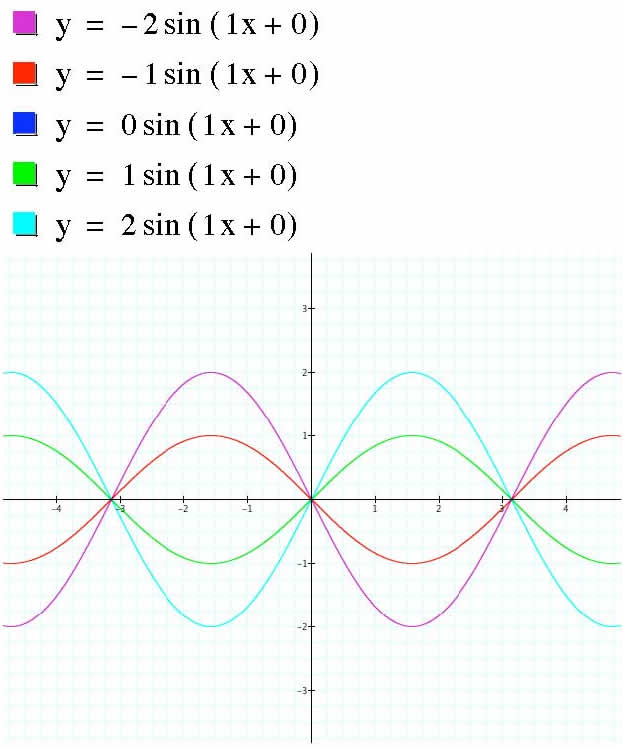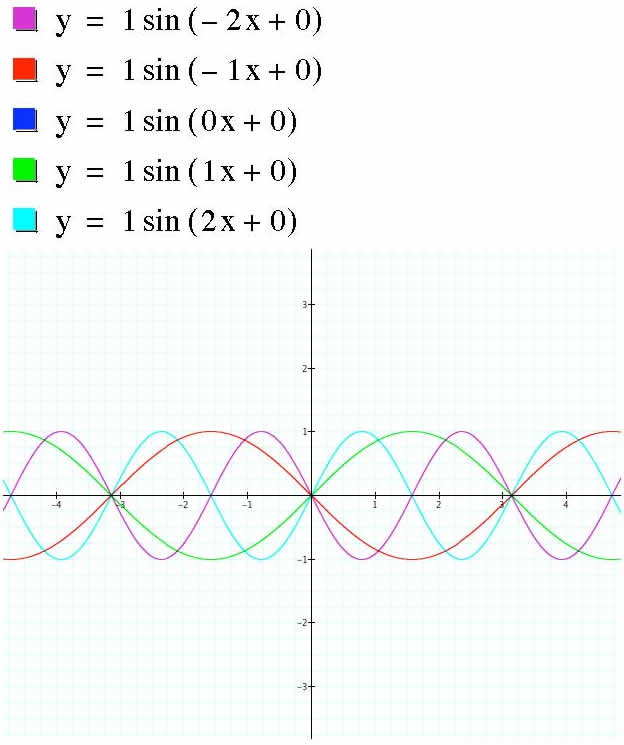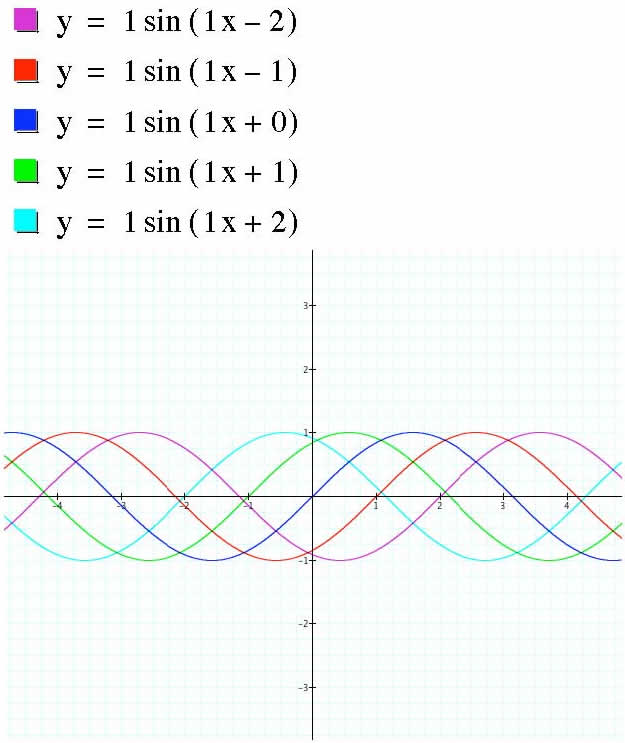
Assignment 1
y = a sin (bx + c)
by Emily Bradley
In examining the graphs of y=a sin(bx+c) it is important to understand how
each parameter (given by a, b, and c) affects the basic sine function y=sinx
We can notice that in the basic function, a=1, b=1, and c=0.
Amplitude Given by |a|, amplitude is the maximum absolute value of a periodic curve measured along its vertical axis. The range of a sine function is affected by |a| and defined from [-|a|, |a|].
| By manipulating a (keeping the basic b and c) we can examine the effects of this parameter. For this examination a={-2, -1, 0, 1, 2}. We notice that for a=1, the basic function is given with amplitude=1 and range from [-1,1]. When a=2, the amplitude is 2, the range defined from [-2,2]. When a=-1, the absolute value of a equals 1, so amplitude =1, range is from [-1,1], but the difference is that the function is reflected over the x-axis. The same comparison can be made between a=2 and a=-2. When a=0, the amplitude =0 and f(x)=0. |  |
Period Given by 2π/b, period is the length of one complete cycle. A function with period P will repeat on intervals of length P. The basic sine function is periodic with period 2π because y=sinx=sin(x+2π).
By manipulating b (keeping the basic a and c) we can examine the effects of this parameter. For this examination b={-2, -1, 0, 1, 2}. We notice that for b=1, the basic function is given with P=2π/1=2π. The cycle is completed by 2π and half the cycle completed by π. When b=2, P=2π/2=π. For b=-1, P=2π/-1=-2π. The function is a reflection of b=1 over the x-axis. The same comparison can be made between b=2 and b=-2. When b=0, P=2π/0 which is undefined so the function does not exist. |
 |
Phase Shift Given by -c/b, phase shift is the shift along the horizontal axis from the zero phase.
By manipulating c (keeping the basic a and b) we can examine the effects of this parameter. For this examination c={-2, -1, 0, 1, 2}. This time the basic value of c=0, and the basic function stays at zero phase. We notice that for c=1, the phase shift is -1/1=-1. Thus the function moves to the left by 1. When b=2, phase shift is -2/1=-2 and the function moves left two. The function moves to the right with c=-1, -2. |
 |
Phase shift depends on b and c. Whether or not the function is positive depends on a and b.
In the last examination we had a varying c, with the value of b equal to 1. A negative b affects this phase shift differently. When -c/b < 0 the function shifts to the left. One case is when c>0, b>0 (grey and yellow'), the other when c<0, b<0 (yellow and grey'). When -c/b > 0 the function shifts to the right. One case is when c>0, b<0 (blue and black'), the other when c<0, b>0 (black and blue').
When ab>0 the function is positive. One case is when a>0, b>0 (grey and black), the other when a<0, b<0 (grey' and black'). When ab<0 the function is negative (a reflection across the x axis from the original graph. One case is when a>0, b<0 (blue and yellow), the other when a<0, b>0 (blue' and yellow'). |
 |
The following two problems are applications of these concepts. The first problem is designed for students to use a given formula and produce a graph. The second problem is designed for students to use a given graph and find the formula.
| Problem | What does the graph of this function look like?  |
||||||||||||||||||||||||||||||||||||||||||||||||||||||
| Process | The Range can be determined by the altitude. |a|=3, so the range is [-3,3]. The period is given by P = 2π/b = 2π/2 = π, so the cycle is complete and repeatable by π. Phase shift = -c/b = -(-π/4) = π/4, so the function shifts right by π/4. ab>0, so the sin function is positive. To sketch the graph over one period, we find key points, letting 2x-(π/2) vary over one period. The period in this case goes from 0 to π.
f(x) can be filled in based on the range [-3, 3]
Based on the phase shift, the origin (0, 0) moves right π/4, making the point (π/4, 0), and each subsequent point moves right by π/4.
|
||||||||||||||||||||||||||||||||||||||||||||||||||||||
| Solution |  |
| Problem | The hill of a rollercoaster begins at ground level and reaches a maximum height of 60' after it has moved approximately 125' horizontally. The hill comes back to ground level by the time it has reached approximately 250' horizontally. Write a sine function to represent this hill (green). *Bonus* Write the sine function that represents the hill reaching double the height in half the distance (blue).
|
| Process | We want to identify the values of a, b, and c in this function. To do so we find the amplitude, period, and phase shift of the graph. The amplitude is 60 as that is the height the hill reaches, so a = 60. Period is given by P = 2π/b. The value for P is given by approximately 500, as half of a period occurs around 250. So, 500 = 2π/b, b=.0126 which is approximately 1/80. We can tell that the phase shift = 0. Therefore -c/b=0 and c=0
*Bonus* For this equation, a is doubled because we double the amplitude value. Also b is doubled, because we are essentially cutting the period in half. |
| Solution |  |
